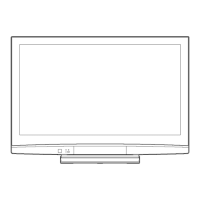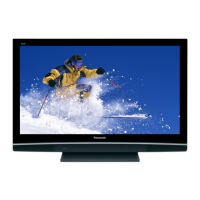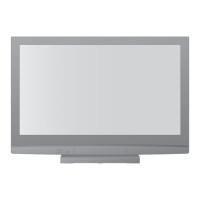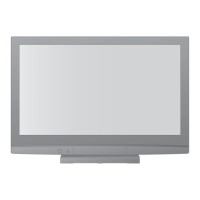Do you have a question about the Panasonic TH-42PV8DA and is the answer not in the manual?
Guidelines for servicing, ensuring protective devices are installed, and performing leakage current checks.
Procedure for checking touch currents between exposed metallic parts and earth ground.
Techniques to reduce component damage from electrostatic discharge during servicing.
Information on lead-free solder (Sn+Ag+Cu) used in manufacturing and recommended for repair.
Important notices, including model name identification and discontinuation of older models.
Table listing different Printed Circuit Boards (PCBs) with their part numbers and descriptions.
Instructions on how to set the plasma unit for servicing and remove the rear cover.
Details on applicable input signals, including resolution and frequency for HDMI and PC.
Technical specifications of the television, including power, panel details, sound, and connections.
Specifications for monitor output, additional connections like HDMI/PC input, and card slot.
Step-by-step instructions on how to access the service mode using the remote control.
Explanation of the key commands used for navigating and adjusting settings within the service mode.
Details of adjustable parameters and instructions on how to exit the service mode.
Accessing and using the service tool mode for diagnostic purposes.
How to display and interpret SOS History and Power On Time/Count data.
Purpose, access, and explanation of the hotel mode setup menu for restricting functions.
Procedures to access the self-check function for IIC bus lines and confirm check points.
Description of screen display during self-check and how to exit the mode.
Chart detailing LED blinking patterns to identify defective blocks when abnormalities occur.
Troubleshooting steps for cases where the unit does not power on, indicated by the power LED.
Troubleshooting flowchart for diagnosing issues when the screen displays no picture.
Identification of possible defective PCBs for local area failures on the plasma screen.
Instructions for removing the rear cover and the P-Board, including safety precautions.
Instructions for removing the rear terminal cover by unscrewing it.
Steps for removing the tuner unit, GS-Board, and A-Board.
Instructions for removing the SU, SD, SC, and SS-Boards.
Steps for removing stand brackets, C1-Board, C2-Board, and the front bracket.
Instructions for removing the G-Board, speakers, S-Board, and K-Board.
Detailed steps for removing the plasma panel section from the cabinet assembly.
Step-by-step instructions for replacing the plasma panel, including connecting boards and fitting hooks.
Preparation steps for driver set-up, including inputting signals and setting picture controls.
Adjusting driver section voltages using a multimeter, referring to panel data.
Cautionary notes and quick adjustment procedures after exchanging a Printed Circuit Board (PCB).
Shows the location of adjustment volumes and test points used for measurements.
A detailed block diagram illustrating the overall system architecture of the television.
Block diagram illustrating the main block (tuner side) and power supply section.
Block diagram illustrating connections for audio processing, HDMI, and various input/output terminals.
Block diagram showing connections for HDMI processor, A/D converter, and memory interfaces.
Block diagram illustrating the plasma panel driver circuits and power supply connections.
Important cautions regarding the correct assembly and locking of flexible cables.
Diagrams showing the overall wire dressing for the assembly.
Notes on interpreting schematic diagrams, including symbols for resistors, capacitors, and test points.
Schematic diagram of the P-Board (Power Board), part 1 of 6.
Schematic diagram of the P-Board (Power Board), part 2 of 6.
Schematic diagram of the P-Board (Power Board), part 3 of 6.
Schematic diagram of the P-Board (Power Board), part 4 of 6.
Schematic diagram of the P-Board (Power Board), part 5 of 6.
Schematic diagram of the P-Board (Power Board), part 6 of 6.
Schematic diagrams for the G-Board, GS-Board, and K-Board.
Schematic diagram of the A-Board (Main Board), part 1 of 19.
Schematic diagram of the A-Board (Main Board), part 2 of 19.
Schematic diagram of the A-Board (Main Board), part 3 of 19.
Schematic diagram of the A-Board (Main Board), part 4 of 19.
Schematic diagram of the A-Board (Main Board), part 5 of 19.
Schematic diagram of the A-Board (Main Board), part 6 of 19.
Schematic diagram of the A-Board (Main Board), part 7 of 19.
Schematic diagram of the A-Board (Main Board), part 8 of 19.
Schematic diagram of the A-Board (Main Board), part 9 of 19.
Schematic diagram of the A-Board (Main Board), part 10 of 19.
Schematic diagram of the A-Board (Main Board), part 11 of 19.
Schematic diagram of the A-Board (Main Board), part 12 of 19.
Schematic diagram of the A-Board (Main Board), part 13 of 19.
Schematic diagram of the A-Board (Main Board), part 14 of 19.
Schematic diagram of the A-Board (Main Board), part 15 of 19.
Schematic diagram of the A-Board (Main Board), part 16 of 19.
Schematic diagram of the A-Board (Main Board), part 17 of 19.
Schematic diagram of the A-Board (Main Board), part 18 of 19.
Schematic diagram of the A-Board (Main Board), part 19 of 19.
Schematic diagrams for the C1-Board, parts 1 of 2 and 2 of 2.
Schematic diagrams for the C2-Board, parts 1 of 2 and 2 of 2.
Schematic diagrams for the SC-Board, parts 1 of 3, 2 of 3, and 3 of 3.
Schematic diagrams for the SU-Board, parts 1 of 2 and 2 of 2.
Schematic diagrams for the SD-Board, parts 1 of 2 and 2 of 2.
Schematic diagrams for the SS-Board (part 1/2) and S-Board.
Schematic diagram of the SS-Board, part 2 of 2.
Foil and component side views of the P-Board, identifying model numbers.
Foil and component side views of the G, GS, K, and S-Boards.
Foil and component side views of the A-Board, identifying model numbers.
Foil side view of the C1-Board, showing component placement and part numbers.
Foil side view of the C2-Board, showing component placement and part numbers.
Foil side view of the SC-Board, showing component placement and part numbers.
Foil side view of the SU-Board, showing component placement and part numbers.
Foil side view of the SD-Board, showing component placement and part numbers.
Foil side view of the SS-Board, showing component placement and part numbers.
Visual exploded view of the television assembly with numbered parts.
Diagrams illustrating the packing procedure and accessory items included with the television.
Notes regarding the supply of parts, distinguishing between general parts and PAVCSG supplied parts.
List of safety-related and mechanical replacement parts with their part numbers and quantities.
Continuation of the replacement parts list, including cables and rear covers.
Continuation of the replacement parts list, including screws and inlet assembly.
Notes regarding component identification, special characteristics, and manufacturer's specified parts.
List of electrical replacement parts, including connectors and capacitors.
Continuation of the electrical replacement parts list, including ICs, transistors, and test points.
Continuation of the electrical replacement parts list, including ICs, transistors, and test points.
Guidelines for servicing, ensuring protective devices are installed, and performing leakage current checks.
Procedure for checking touch currents between exposed metallic parts and earth ground.
Techniques to reduce component damage from electrostatic discharge during servicing.
Information on lead-free solder (Sn+Ag+Cu) used in manufacturing and recommended for repair.
Important notices, including model name identification and discontinuation of older models.
Table listing different Printed Circuit Boards (PCBs) with their part numbers and descriptions.
Instructions on how to set the plasma unit for servicing and remove the rear cover.
Details on applicable input signals, including resolution and frequency for HDMI and PC.
Technical specifications of the television, including power, panel details, sound, and connections.
Specifications for monitor output, additional connections like HDMI/PC input, and card slot.
Step-by-step instructions on how to access the service mode using the remote control.
Explanation of the key commands used for navigating and adjusting settings within the service mode.
Details of adjustable parameters and instructions on how to exit the service mode.
Accessing and using the service tool mode for diagnostic purposes.
How to display and interpret SOS History and Power On Time/Count data.
Purpose, access, and explanation of the hotel mode setup menu for restricting functions.
Procedures to access the self-check function for IIC bus lines and confirm check points.
Description of screen display during self-check and how to exit the mode.
Chart detailing LED blinking patterns to identify defective blocks when abnormalities occur.
Troubleshooting steps for cases where the unit does not power on, indicated by the power LED.
Troubleshooting flowchart for diagnosing issues when the screen displays no picture.
Identification of possible defective PCBs for local area failures on the plasma screen.
Instructions for removing the rear cover and the P-Board, including safety precautions.
Instructions for removing the rear terminal cover by unscrewing it.
Steps for removing the tuner unit, GS-Board, and A-Board.
Instructions for removing the SU, SD, SC, and SS-Boards.
Steps for removing stand brackets, C1-Board, C2-Board, and the front bracket.
Instructions for removing the G-Board, speakers, S-Board, and K-Board.
Detailed steps for removing the plasma panel section from the cabinet assembly.
Step-by-step instructions for replacing the plasma panel, including connecting boards and fitting hooks.
Preparation steps for driver set-up, including inputting signals and setting picture controls.
Adjusting driver section voltages using a multimeter, referring to panel data.
Cautionary notes and quick adjustment procedures after exchanging a Printed Circuit Board (PCB).
Shows the location of adjustment volumes and test points used for measurements.
A detailed block diagram illustrating the overall system architecture of the television.
Block diagram illustrating the main block (tuner side) and power supply section.
Block diagram illustrating connections for audio processing, HDMI, and various input/output terminals.
Block diagram showing connections for HDMI processor, A/D converter, and memory interfaces.
Block diagram illustrating the plasma panel driver circuits and power supply connections.
Important cautions regarding the correct assembly and locking of flexible cables.
Diagrams showing the overall wire dressing for the assembly.
Notes on interpreting schematic diagrams, including symbols for resistors, capacitors, and test points.
Schematic diagram of the P-Board (Power Board), part 1 of 6.
Schematic diagram of the P-Board (Power Board), part 2 of 6.
Schematic diagram of the P-Board (Power Board), part 3 of 6.
Schematic diagram of the P-Board (Power Board), part 4 of 6.
Schematic diagram of the P-Board (Power Board), part 5 of 6.
Schematic diagram of the P-Board (Power Board), part 6 of 6.
Schematic diagrams for the G-Board, GS-Board, and K-Board.
Schematic diagram of the A-Board (Main Board), part 1 of 19.
Schematic diagram of the A-Board (Main Board), part 2 of 19.
Schematic diagram of the A-Board (Main Board), part 3 of 19.
Schematic diagram of the A-Board (Main Board), part 4 of 19.
Schematic diagram of the A-Board (Main Board), part 5 of 19.
Schematic diagram of the A-Board (Main Board), part 6 of 19.
Schematic diagram of the A-Board (Main Board), part 7 of 19.
Schematic diagram of the A-Board (Main Board), part 8 of 19.
Schematic diagram of the A-Board (Main Board), part 9 of 19.
Schematic diagram of the A-Board (Main Board), part 10 of 19.
Schematic diagram of the A-Board (Main Board), part 11 of 19.
Schematic diagram of the A-Board (Main Board), part 12 of 19.
Schematic diagram of the A-Board (Main Board), part 13 of 19.
Schematic diagram of the A-Board (Main Board), part 14 of 19.
Schematic diagram of the A-Board (Main Board), part 15 of 19.
Schematic diagram of the A-Board (Main Board), part 16 of 19.
Schematic diagram of the A-Board (Main Board), part 17 of 19.
Schematic diagram of the A-Board (Main Board), part 18 of 19.
Schematic diagram of the A-Board (Main Board), part 19 of 19.
Schematic diagrams for the C1-Board, parts 1 of 2 and 2 of 2.
Schematic diagrams for the C2-Board, parts 1 of 2 and 2 of 2.
Schematic diagrams for the SC-Board, parts 1 of 3, 2 of 3, and 3 of 3.
Schematic diagrams for the SU-Board, parts 1 of 2 and 2 of 2.
Schematic diagrams for the SD-Board, parts 1 of 2 and 2 of 2.
Schematic diagrams for the SS-Board (part 1/2) and S-Board.
Schematic diagram of the SS-Board, part 2 of 2.
Foil and component side views of the P-Board, identifying model numbers.
Foil and component side views of the G, GS, K, and S-Boards.
Foil and component side views of the A-Board, identifying model numbers.
Foil side view of the C1-Board, showing component placement and part numbers.
Foil side view of the C2-Board, showing component placement and part numbers.
Foil side view of the SC-Board, showing component placement and part numbers.
Foil side view of the SU-Board, showing component placement and part numbers.
Foil side view of the SD-Board, showing component placement and part numbers.
Foil side view of the SS-Board, showing component placement and part numbers.
Visual exploded view of the television assembly with numbered parts.
Diagrams illustrating the packing procedure and accessory items included with the television.
Notes regarding the supply of parts, distinguishing between general parts and PAVCSG supplied parts.
List of safety-related and mechanical replacement parts with their part numbers and quantities.
Continuation of the replacement parts list, including cables and rear covers.
Continuation of the replacement parts list, including screws and inlet assembly.
Notes regarding component identification, special characteristics, and manufacturer's specified parts.
List of electrical replacement parts, including connectors and capacitors.
Continuation of the electrical replacement parts list, including ICs, transistors, and test points.
Continuation of the electrical replacement parts list, including ICs, transistors, and test points.
| Screen Size | 42 inches |
|---|---|
| Display Type | Plasma |
| Resolution | 1024 x 768 |
| HDMI Ports | 2 |
| Contrast Ratio | 10000:1 |
| Brightness | 1500 cd/m² |
| Aspect Ratio | 16:9 |
| Viewing Angle | 160 degrees |
| VGA Input | Yes |
| Component Video Input | Yes |
| Composite Video Input | Yes |
| S-Video Input | Yes |
| RF Input | Yes |
| Speaker Output | 20 W (10 W x 2) |











